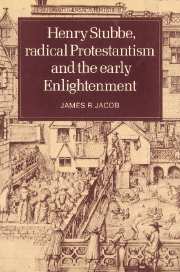Book contents
- Frontmatter
- Contents
- Miscellaneous Frontmatter
- Preface
- Introduction: the historiographical problem
- 1 Hobbesian Independent
- 2 Republican Independent
- 3 Surreptitious naturalism: the invention of a new rhetoric
- 4 ‘Mahometan Christianity’: Stubbe's secular historicism
- 5 Aristotle on the ale-benches
- 6 Court pen: ‘ancient prudence’ and royal policy
- 7 Court to country
- 8 Civil religion and radical politics: Stubbe to Toland
- Epilogue: the paganizing thread
- Notes
- Bibliographical Note
- Index
Introduction: the historiographical problem
Published online by Cambridge University Press: 14 October 2009
- Frontmatter
- Contents
- Miscellaneous Frontmatter
- Preface
- Introduction: the historiographical problem
- 1 Hobbesian Independent
- 2 Republican Independent
- 3 Surreptitious naturalism: the invention of a new rhetoric
- 4 ‘Mahometan Christianity’: Stubbe's secular historicism
- 5 Aristotle on the ale-benches
- 6 Court pen: ‘ancient prudence’ and royal policy
- 7 Court to country
- 8 Civil religion and radical politics: Stubbe to Toland
- Epilogue: the paganizing thread
- Notes
- Bibliographical Note
- Index
Summary
This book is a piece of detective work in more than the usual sense. Not only is it the first book-length treatment devoted to its principal subject, the career and influence of Henry Stubbe; it is also an attempt to solve a puzzle, and this is where the real detective work comes in. Henry Stubbe has received a bad historical press. His career has been divided into two parts by those scholars who have studied him. In the first part, up to 1660, he is quite rightly seen as a republican Independent, a late Interregnum apologist for the ‘good old cause’ and a spokesman for Sir Henry Vane the Younger. In the second part after the Restoration, however, he has been cast, quite wrongly as it turns out, in the role of a turncoat who rejected the Revolution and became a conservative defender of the established church, the monarchy and Scholastic learning against innovation and particularly against the innovations represented by the new philosophy of the Royal Society and its principal advocates Thomas Sprat and Joseph Glanvill. It is his published attacks on them that have commanded the most scholarly attention, and quite rightly too because they probably constitute the most sustained and vociferous polemical challenge that the Society has ever faced. Stubbe's attacks, moreover, are especially important because they occur at the very moment when the new philosophy and the modern idea of science and its applications were being formulated and institutionalized.
- Type
- Chapter
- Information
- Publisher: Cambridge University PressPrint publication year: 1983



